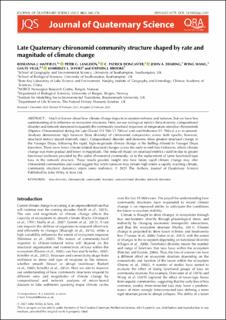| dc.contributor.author | Mayfield, Roseanna J. | |
| dc.contributor.author | Langdon, Peter G. | |
| dc.contributor.author | Doncaster, C. Patrick | |
| dc.contributor.author | Dearing, John A. | |
| dc.contributor.author | Wang, Rong | |
| dc.contributor.author | Velle, Gaute | |
| dc.contributor.author | Davies, Kimberley L. | |
| dc.contributor.author | Brooks, Stephen J. | |
| dc.date.accessioned | 2022-03-11T09:03:21Z | |
| dc.date.available | 2022-03-11T09:03:21Z | |
| dc.date.created | 2021-12-14T11:40:17Z | |
| dc.date.issued | 2021 | |
| dc.identifier.citation | Journal of Quaternary Science. 2021, 36 (3), 360-376. | en_US |
| dc.identifier.issn | 0267-8179 | |
| dc.identifier.uri | https://hdl.handle.net/11250/2984512 | |
| dc.description.abstract | Much is known about how climate change impacts ecosystem richness and turnover, but we have less understanding of its influence on ecosystem structures. Here, we use ecological metrics (beta diversity, compositional disorder and network skewness) to quantify the community structural responses of temperature-sensitive chironomids (Diptera: Chironomidae) during the Late Glacial (14 700–11 700 cal a bp) and Holocene (11 700 cal a bp to present). Analyses demonstrate high turnover (beta diversity) of chironomid composition across both epochs; however, structural metrics stayed relatively intact. Compositional disorder and skewness show greatest structural change in the Younger Dryas, following the rapid, high-magnitude climate change at the Bølling–Allerød to Younger Dryas transition. There were fewer climate-related structural changes across the early to mid–late Holocene, where climate change was more gradual and lower in magnitude. The reduced impact on structural metrics could be due to greater functional resilience provided by the wider chironomid community, or to the replacement of same functional-type taxa in the network structure. These results provide insight into how future rapid climate change may alter chironomid communities and could suggest that while turnover may remain high under a rapidly warming climate, community structural dynamics retain some resilience. | en_US |
| dc.language.iso | eng | en_US |
| dc.rights | Navngivelse 4.0 Internasjonal | * |
| dc.rights.uri | http://creativecommons.org/licenses/by/4.0/deed.no | * |
| dc.title | Late Quaternary chironomid community structure shaped by rate and magnitude of climate change | en_US |
| dc.type | Peer reviewed | en_US |
| dc.type | Journal article | en_US |
| dc.rights.holder | © The Authors, 2021 | en_US |
| dc.description.version | publishedVersion | en_US |
| cristin.ispublished | true | |
| cristin.fulltext | original | |
| cristin.qualitycode | 1 | |
| dc.identifier.doi | 10.1002/jqs.3301 | |
| dc.identifier.cristin | 1968285 | |
| dc.source.journal | Journal of Quaternary Science | en_US |
| dc.source.volume | 36 | en_US |
| dc.source.issue | 3 | en_US |
| dc.source.pagenumber | 360-376 | en_US |
| dc.relation.project | Norges forskningsråd: 250963 | en_US |

